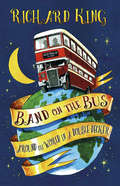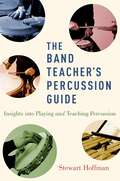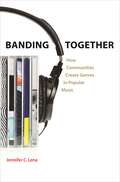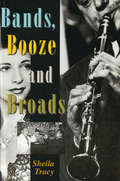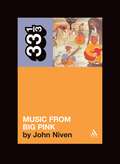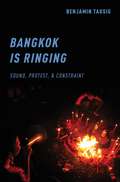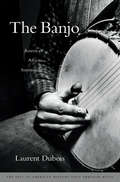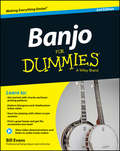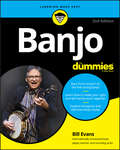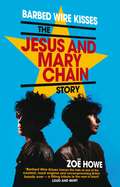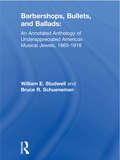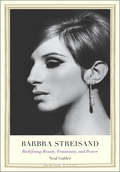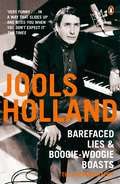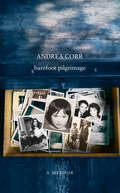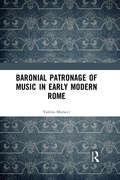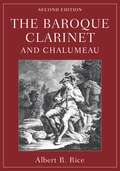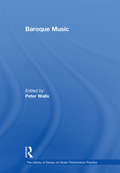- Table View
- List View
Band on the Bus: Around the World in a Double-Decker
by Richard KingWhen nine friends set out from England in 1969 to travel the world in a double-decker bus called ‘Hairy Pillock’, little did they know that they would become honorary citizens of Texas, hold the keys to New York, release a record in Australia, perform for the Shah and Empress of Iran, and appear on countless television and radio shows around the world. Their epic three-year journey, which began as a bet with the landlord of their local pub, took them across perilous roads through Europe to Iran and Afghanistan, through the Khyber Pass to Pakistan and India, then to Australia and, finally, the United States and Canada. Initially planning on getting work as export salesmen, they soon had to supplement their meagre funds by performing the folk songs they sang in the pubs back home, after which they achieved minor stardom as The Philanderers throughout Australia and the US. This light-hearted account follows the group on their trip across deserts and mountains, as they undertook an incredible expedition that would be impossible today.
BAND TEACHER'S PERCUSSION C: Insights into Playing and Teaching Percussion
by Stewart HoffmanThe Band Teacher's Percussion Guide: Insights into Playing and Teaching Percussion is an essential practical resource for instrumental music teachers and band directors. Author Stewart Hoffman, a Juilliard-trained percussionist, performer, private instructor, and former classroom teacher, offers a comprehensive yet accessible and clearly written handbook to help set teachers and students alike firmly on the road to classroom success. In this book, he presents a thorough foundation in snare drum, timpani, keyboard percussion, drum set, and auxiliary and Latin percussion techniques. More than this, he provides practical advice on curriculum and methodology, packing page after page with teaching tips developed through decades of experience. For educators and band directors who want to learn more about percussion instruments and playing techniques, refine their percussion-teaching skills, or set the classroom stage for a more effective and rewarding teaching experience, The Band Teacher's Percussion Guide: Insights into Playing and Teaching Percussion will be a valued resource for discovering: · keys to effective evaluation · how to plan a percussion program and select percussionists · recommended instruments and mallets; repair and maintenance guidelines · lifts and levels, a system that leads students to greater control and a more relaxed snare drum technique · technical exercises for all main and accessory percussion instruments · easily referenced summaries of points to focus on when practicing · guidelines for teaching jazz, Latin and rock drumset Visit the companion website at www.oup.com/us/bandteacherspercussionguide
The Band Teacher's Percussion Guide: Insights into Playing and Teaching Percussion
by Stewart HoffmanThe Band Teacher's Percussion Guide: Insights into Playing and Teaching Percussion is an essential practical resource for instrumental music teachers and band directors. Author Stewart Hoffman, a Juilliard-trained percussionist, performer, private instructor, and former classroom teacher, offers a comprehensive yet accessible and clearly written handbook to help set teachers and students alike firmly on the road to classroom success. In this book, he presents a thorough foundation in snare drum, timpani, keyboard percussion, drum set, and auxiliary and Latin percussion techniques. More than this, he provides practical advice on curriculum and methodology, packing page after page with teaching tips developed through decades of experience. For educators and band directors who want to learn more about percussion instruments and playing techniques, refine their percussion-teaching skills, or set the classroom stage for a more effective and rewarding teaching experience, The Band Teacher's Percussion Guide: Insights into Playing and Teaching Percussion will be a valued resource for discovering: · keys to effective evaluation · how to plan a percussion program and select percussionists · recommended instruments and mallets; repair and maintenance guidelines · lifts and levels, a system that leads students to greater control and a more relaxed snare drum technique · technical exercises for all main and accessory percussion instruments · easily referenced summaries of points to focus on when practicing · guidelines for teaching jazz, Latin and rock drumset Visit the companion website at www.oup.com/us/bandteacherspercussionguide
Banding Together: How Communities Create Genres in Popular Music
by Jennifer C. LenaWhy do some music styles gain mass popularity while others thrive in small niches? Banding Together explores this question and reveals the attributes that together explain the growth of twentieth-century American popular music. Drawing on a vast array of examples from sixty musical styles--ranging from rap and bluegrass to death metal and South Texas polka, and including several created outside the United States--Jennifer Lena uncovers the shared grammar that allows us to understand the cultural language and evolution of popular music. What are the common economic, organizational, ideological, and aesthetic traits among contemporary genres? Do genres follow patterns in their development? Lena discovers four dominant forms--Avant-garde, Scene-based, Industry-based, and Traditionalist--and two dominant trajectories that describe how American pop music genres develop. Outside the United States there exists a fifth form: the Government-purposed genre, which she examines in the music of China, Serbia, Nigeria, and Chile. Offering a rare analysis of how music communities operate, she looks at the shared obstacles and opportunities creative people face and reveals the ways in which people collaborate around ideas, artworks, individuals, and organizations that support their work.
Banding Together: How Communities Create Genres in Popular Music (PDF)
by Jennifer C. LenaWhy do some music styles gain mass popularity while others thrive in small niches? Banding Together explores this question and reveals the attributes that together explain the growth of twentieth-century American popular music. Drawing on a vast array of examples from sixty musical styles--ranging from rap and bluegrass to death metal and South Texas polka, and including several created outside the United States--Jennifer Lena uncovers the shared grammar that allows us to understand the cultural language and evolution of popular music. What are the common economic, organizational, ideological, and aesthetic traits among contemporary genres? Do genres follow patterns in their development? Lena discovers four dominant forms--Avant-garde, Scene-based, Industry-based, and Traditionalist--and two dominant trajectories that describe how American pop music genres develop. Outside the United States there exists a fifth form: the Government-purposed genre, which she examines in the music of China, Serbia, Nigeria, and Chile. Offering a rare analysis of how music communities operate, she looks at the shared obstacles and opportunities creative people face and reveals the ways in which people collaborate around ideas, artworks, individuals, and organizations that support their work.
Bands, Booze And Broads
by Sheila TracyIn this captivating study of one of our most popular music genres, Sheila Tracy goes behind the scenes and talks to over 60 Americans who played with the most famous big bands - and who lived to tell the tale. This was no mean feat: swing music''s huge popularity brought the performers wild adulation and, for many, resorting to drugs and alcohol was the only way to keep up. These musicians relate their incredible experiences of life on the road, where the pressure to party every night was enormous.
The Band's Music from Big Pink (33 1/3)
by John Niven"Music From Big Pink is a moving book that succeeds not just in vividly evoking its time and place but in distilling one young man's cliched and minor destiny into something approaching tragedy....This well-written first novel captures not just some of the dreams of that bygone era, but the way those dreams died." -Greg Kamiya, The New York Times Book ReviewMusic From Big Pink is faction: real people like Richard Manuel, Rick Danko, Bob Dylan and Albert Grossman rub shoulders with fictional characters and actual, documented events thread their way through text alongside imagined scenarios. Through the eyes of 23-year-old Greg Keltner, drug-dealer and wannabe musician, we witness the gestation and birth of a record that will go on to cast its spell across five decades - bewitching and inspiring artists as disparate as The Beatles, Eric Clapton, Travis, Wilco and Mercury Rev. Booksellers contact reviews@continuum-books.com for a reading copy, while supplies last!
Bangkok is Ringing: Sound, Protest, and Constraint
by Benjamin TausigWinner of the 2020 British Forum for Ethnomusicology Book Prize Bangkok Is Ringing is an on-the-ground sound studies analysis of the political protests that transformed Thailand in 2010-11. Bringing the reader through sixteen distinct "sonic niches" where dissidents used media to broadcast to both local and diffuse audiences, the book catalogues these mass protests in a way that few movements have ever been catalogued. The Red Shirt and Yellow Shirt protests that shook Thailand took place just before other international political movements, including the Arab Spring and Occupy Wall Street. Bangkok Is Ringing analyzes the Thai protests in comparison with these, seeking to understand the logic not only of political change in Thailand, but across the globe. The book is attuned to sound in a great variety of forms. Author Benjamin Tausig traces the history and use in protest of specific media forms, including community radio, megaphones, CDs, and live concerts. The research took place over the course of sixteen months, and the author worked closely with musicians, concert promoters, activists, and rank-and-file protesters. The result is a detailed and sensitive ethnography that argues for an understanding of sound and political movements in tandem. In particular, it emphasizes the necessity of thinking through constraint as a fundamental condition of both political movements and the sound that these movements produce. In order to produce political transformations, Bangkok Is Ringing argues, dissidents must be sensitive to the ways that their sounding is constrained and channeled.
Bangkok is Ringing: Sound, Protest, and Constraint
by Benjamin TausigWinner of the 2020 British Forum for Ethnomusicology Book Prize Bangkok Is Ringing is an on-the-ground sound studies analysis of the political protests that transformed Thailand in 2010-11. Bringing the reader through sixteen distinct "sonic niches" where dissidents used media to broadcast to both local and diffuse audiences, the book catalogues these mass protests in a way that few movements have ever been catalogued. The Red Shirt and Yellow Shirt protests that shook Thailand took place just before other international political movements, including the Arab Spring and Occupy Wall Street. Bangkok Is Ringing analyzes the Thai protests in comparison with these, seeking to understand the logic not only of political change in Thailand, but across the globe. The book is attuned to sound in a great variety of forms. Author Benjamin Tausig traces the history and use in protest of specific media forms, including community radio, megaphones, CDs, and live concerts. The research took place over the course of sixteen months, and the author worked closely with musicians, concert promoters, activists, and rank-and-file protesters. The result is a detailed and sensitive ethnography that argues for an understanding of sound and political movements in tandem. In particular, it emphasizes the necessity of thinking through constraint as a fundamental condition of both political movements and the sound that these movements produce. In order to produce political transformations, Bangkok Is Ringing argues, dissidents must be sensitive to the ways that their sounding is constrained and channeled.
The Banjo: America's African Instrument
by Laurent DuboisAmerican slaves drew on memories of African musical traditions to construct instruments from carved-out gourds covered with animal skin. Providing a sense of rootedness, solidarity, and consolation, banjo picking became an essential part of black plantation life, and its unmistakable sound remains versatile and enduring today, Laurent Dubois shows.
Banjo For Dummies: Book + Online Video and Audio Instruction
by Bill EvansPlay your way to banjo-playing expertise Traditionally associated with country, folk, and bluegrass music, the banjo is accessible to anyone with the patience and willpower to learn it. This second edition of Banjo For Dummies does the rest of the work for you with updated practice lessons, teaching techniques, and step-by-step examples. With this guide, you will learn tips and techniques for selecting the right instruments and accessories, how to develop correct hand position and posture, and how to tune, care for, and make simple repairs to the instrument. An updated multimedia component features companion audio tracks and complementary video lessons that cement the concepts readers gain during their reading. Written by Bill Evans, an accomplished five-string banjo player, teacher, writer, and historian Includes access to "how-to" videos on Dummies.com Ideal for anyone who wants to learn to play this classic instrument For musicians hoping to lend their art an edge or interested learners looking to pick up a unique skill, Banjo For Dummies is a must-have, straightforward guide to success.
Banjo For Dummies: Book + Online Video and Audio Instruction
by Bill EvansPlay your way to banjo-playing expertise Traditionally associated with country, folk, and bluegrass music, the banjo is accessible to anyone with the patience and willpower to learn it. This second edition of Banjo For Dummies does the rest of the work for you with updated practice lessons, teaching techniques, and step-by-step examples. With this guide, you will learn tips and techniques for selecting the right instruments and accessories, how to develop correct hand position and posture, and how to tune, care for, and make simple repairs to the instrument. An updated multimedia component features companion audio tracks and complementary video lessons that cement the concepts readers gain during their reading. Written by Bill Evans, an accomplished five-string banjo player, teacher, writer, and historian Includes access to "how-to" videos on Dummies.com Ideal for anyone who wants to learn to play this classic instrument For musicians hoping to lend their art an edge or interested learners looking to pick up a unique skill, Banjo For Dummies is a must-have, straightforward guide to success.
Banjo For Dummies: Book + Online Video and Audio Instruction
by Bill EvansStart from scratch on the five-string banjo Learn how to make your right and left hands work together Explore bluegrass and old-time banjo styles Join the banjo revolution! Thanks to its prevalence in folk and bluegrass, the banjo is almost the very essence of Americana. And now a new generation of musicians from the country, pop, and jazz worlds have made the sound of the banjo new again. This book is for anyone who wants to pay their respects to tradition as well as those who want to create the next chart-topper ... or both! Packed with the essentials you need to know—from top techniques to choosing the right instrument—you'll learn, and be able to show off, just why the banjo is never out of style! Inside... Tackle the basics with chords and simple picking patterns Explore historic, traditional, and modern styles Get connected with the banjo world Go beyond the book with online lessons
Banjo For Dummies: Book + Online Video and Audio Instruction
by Bill EvansStart from scratch on the five-string banjo Learn how to make your right and left hands work together Explore bluegrass and old-time banjo styles Join the banjo revolution! Thanks to its prevalence in folk and bluegrass, the banjo is almost the very essence of Americana. And now a new generation of musicians from the country, pop, and jazz worlds have made the sound of the banjo new again. This book is for anyone who wants to pay their respects to tradition as well as those who want to create the next chart-topper ... or both! Packed with the essentials you need to know—from top techniques to choosing the right instrument—you'll learn, and be able to show off, just why the banjo is never out of style! Inside... Tackle the basics with chords and simple picking patterns Explore historic, traditional, and modern styles Get connected with the banjo world Go beyond the book with online lessons
Barbed Wire Kisses: The Jesus and Mary Chain Story
by Zoë HoweThe Mary Chain were the best thing since punk rock' - Bobby Gillespie 'The Jesus and Mary Chain were integral to my musical development' - Trent Reznor, Nine Inch Nails Praise for Zoë Howe: 'A stunning reinvention of the rock memoir format. Zoë Howe bottles Wilko's lightning' - Dave Collins, Vive Le Rock, on Wilko Johnson: Looking Back at Me 'Brit-rock book of the year' - Gavin Martin on Typical Girls? The Story of The Slits Musically, culturally and in terms of sheer attitude, The Jesus and Mary Chain stand alone. Their seminal debut album Psychocandy would change the course of popular music, and their distinctive blend of psychotic white noise, dark lyrics and a pop sensibility continues to enchant and confound to this day. This book takes us behind the wall of distortion to reveal the fierce, frank and often funny tale of The Jesus and Mary Chain, told by the band members and their associates for the first time. Author Zoë Howe charts each step of the Mary Chain's journey up to the present day, chronicling the formation of the group, their incendiary live performances, the Reids' powerful songcraft and those famous fraternal tensions that would prepare Creation Records boss Alan McGee for the onslaught of the Gallaghers. Thirty years after the Mary Chain formed, it is time this influential group and sometime 'public enemy' had their say. Includes new and exclusive interviews with Jim Reid, Douglas Hart, Bobby Gillespie, Alan McGee, Murray Dalglish, Laurence Verfaillie, John Moore, Ben Lurie, Stephen Pastel and many others.
Barbershops, Bullets, and Ballads: An Annotated Anthology of Underappreciated American Musical Jewels, 1865-1918
by William E Studwell Bruce R SchuenemanThrough Barbershops, Bullets, and Ballads: An Annotated Anthology of Underappreciated American Musical Jewels, 1865--1918, you will discover older musical gems written during a half-century period of geographical, economic, political, and cultural expansion in the United States. Due to the fact that our collective American consciousness is rapidly developing cultural amnesia about or indifference to many of these older songs, the authors felt that a scholarly anthology needed to be produced before another century and millennium overwhelmed us. With Barbershops, Bullets, and Ballads, you will discover academic composers such as Arthur Foote, George Chadwick, and Amy Beach and find annotations outlining the history of the songs as well as the actual words and music.Barbershops, Bullets, and Ballads reveals to you such underappreciated songs as: “Above in Her Chamber,” with music by Julius Eichberg and lyrics by poet Celia Thaxter “In the Evening by the Moonlight,” with music and lyrics by James A. Bland “My Wild Irish Rose,” with music and lyrics by Chauncey Olcott “Cheyenne,” by lyricist Harry H. Williams and composer Egbert Van Alstyne “Come, Josephine in My Flying Machine,” with music by Fred Fisher and lyrics by Alfred BryanIn Barbershops, Bullets, and Ballads, you will find sections containing historical notes of featured songs in chronological order. Through this remarkable collection, you will discover an anthology of popular music of the bygone “golden age” of song and take a pleasurable voyage back to a time that is long gone.
Barbershops, Bullets, and Ballads: An Annotated Anthology of Underappreciated American Musical Jewels, 1865-1918
by William E Studwell Bruce R SchuenemanThrough Barbershops, Bullets, and Ballads: An Annotated Anthology of Underappreciated American Musical Jewels, 1865--1918, you will discover older musical gems written during a half-century period of geographical, economic, political, and cultural expansion in the United States. Due to the fact that our collective American consciousness is rapidly developing cultural amnesia about or indifference to many of these older songs, the authors felt that a scholarly anthology needed to be produced before another century and millennium overwhelmed us. With Barbershops, Bullets, and Ballads, you will discover academic composers such as Arthur Foote, George Chadwick, and Amy Beach and find annotations outlining the history of the songs as well as the actual words and music.Barbershops, Bullets, and Ballads reveals to you such underappreciated songs as: “Above in Her Chamber,” with music by Julius Eichberg and lyrics by poet Celia Thaxter “In the Evening by the Moonlight,” with music and lyrics by James A. Bland “My Wild Irish Rose,” with music and lyrics by Chauncey Olcott “Cheyenne,” by lyricist Harry H. Williams and composer Egbert Van Alstyne “Come, Josephine in My Flying Machine,” with music by Fred Fisher and lyrics by Alfred BryanIn Barbershops, Bullets, and Ballads, you will find sections containing historical notes of featured songs in chronological order. Through this remarkable collection, you will discover an anthology of popular music of the bygone “golden age” of song and take a pleasurable voyage back to a time that is long gone.
Barbra Streisand: Redefining Beauty, Femininity, and Power (Jewish Lives)
by Neal GablerBarbra Streisand has been called the “most successful...talented performer of her generation” by Vanity Fair, and her voice, said pianist Glenn Gould, is “one of the natural wonders of the age.” Streisand scaled the heights of entertainment—from a popular vocalist to a first-rank Broadway star in Funny Girl to an Oscar-winning actress to a producer and director. But she has also become a cultural icon who has transcended show business. To achieve her success, Brooklyn-born Streisand had to overcome tremendous odds, not the least of which was her Jewishness. Dismissed, insulted, even reviled when she embarked on a show business career for acting too Jewish and looking too Jewish, she brilliantly converted her Jewishness into a metaphor for outsiderness that would eventually make her the avenger for anyone who felt marginalized and powerless. Neal Gabler examines Streisand’s life and career through this prism of otherness—a Jew in a gentile world, a self-proclaimed homely girl in a world of glamour, a kooky girl in a world of convention—and shows how central it was to Streisand’s triumph as one of the voices of her age.
Barefaced Lies and Boogie-Woogie Boasts
by Harriet Vyner Jools HollandJools Holland has had a fascinating life. From playing on bomb sites as a boy in the East End, to skiving off school and then selling millions of records with Squeeze, the first twenty years of his life were eventful, chaotic and colourful. Then came The Tube with Paula Yates, the seminal live music programme that propelled him to fame. Over the following three decades, Jools succeeded in placing himself at the epicentre of a global community comprising just about anybody who is anybody in music. Through Later with Jools Holland, the longest-running music programme on television, he has given British TV debuts to countless now world famous bands. Packed with hilarious anecdotes written in Holland’s own inimitable style and laced with quirky insights and deliciously acute detail, this autobiography by one of Britain’s most gifted and debonaire musicians is not just for music fans, but for anyone who is looking for something several cuts above the conventional showbiz memoir.
Barefoot Pilgrimage
by Andrea CorrAndrea Corr’s Barefoot Pilgrimage is a compelling and honest memoir.
Baronial Patronage of Music in Early Modern Rome
by Valerio MorucciThis is the first dedicated study of the musical patronage of Roman baronial families in the sixteenth and early seventeenth centuries. Patronage – the support of a person or institution and their work by a patron – in Renaissance society was the basis of a complex network of familial and political relationships between clients and patrons, whose ideas, values, and norms of behavior were shared with the collective. Bringing to light new archival documentation, this book examines the intricate network of patronage interrelationships in Rome. Unlike other Italian cities where political control was monocentric and exercised by single rulers, sources of patronage in Rome comprised a multiplicity of courts and potential patrons, which included the pope, high prelates, nobles and foreign diplomats. Morucci uses archival records, and the correspondence of the Orsini and Colonna families in particular, to investigate the local activity and circulation of musicians and the cultivation of music within the broader civic network of Roman aristocratic families over the period. The author also shows that the familial union of the Medici and Orsini families established a bidirectional network for artistic exchange outside of the Eternal City, and that the Orsini-Colonna circle represented a musical bridge between Naples, Rome, and Florence.
Baronial Patronage of Music in Early Modern Rome
by Valerio MorucciThis is the first dedicated study of the musical patronage of Roman baronial families in the sixteenth and early seventeenth centuries. Patronage – the support of a person or institution and their work by a patron – in Renaissance society was the basis of a complex network of familial and political relationships between clients and patrons, whose ideas, values, and norms of behavior were shared with the collective. Bringing to light new archival documentation, this book examines the intricate network of patronage interrelationships in Rome. Unlike other Italian cities where political control was monocentric and exercised by single rulers, sources of patronage in Rome comprised a multiplicity of courts and potential patrons, which included the pope, high prelates, nobles and foreign diplomats. Morucci uses archival records, and the correspondence of the Orsini and Colonna families in particular, to investigate the local activity and circulation of musicians and the cultivation of music within the broader civic network of Roman aristocratic families over the period. The author also shows that the familial union of the Medici and Orsini families established a bidirectional network for artistic exchange outside of the Eternal City, and that the Orsini-Colonna circle represented a musical bridge between Naples, Rome, and Florence.
The Baroque Clarinet and Chalumeau
by Albert R. RiceThe first edition of Albert R. Rice's The Baroque Clarinet is widely considered the authoritative text on the European clarinet during the first half of the eighteenth century. Since its publication in 1992, its conclusions have influenced the approaches of musicologists, instrument historians, and clarinet performers. Twenty-eight years later, Rice has updated his renowned study in a second edition, with new chapters on chalumeau and clarinet music, insights on newly found instruments and additional material on the Baroque clarinet in society. Expanding the volume to include the chalumeau, close cousin and predecessor to the clarinet, Rice draws on nearly three decades of new research on the instrument's origins and music. Discoveries include two recently found chalumeaux in a private collection, one by Johann Heinrich Eichentopf of Leipzig, and attributions based on historical evidence for three more chalumeaux. Rice furthers the discussion to recently uncovered early instruments and historical scores, which shed light on the clarinet's evolution. Most essentially, Rice highlights the chalumeau's substantial late-seventeenth and early-eighteenth century repertory, comprising over 330 works by 66 composers, and includes a more expansive list of surviving Baroque clarinet works, organized by date, composer, and tonality/range. The Baroque Clarinet and Chalumeau provides a long-awaited follow-up to Rice's groundbreaking volume, drawing from a variety of sources-including German, Italian, Dutch, Swedish, Norwegian, Danish, Finnish, Flemish, Czech, and Catalan research-to bring this new information to an English-speaking audience. With his dedication to scholarly accuracy, Rice brings the Baroque clarinet into sharper focus than ever before.
BAROQUE CLARINET & CHALUMEAU 2E C
by Albert R. RiceThe first edition of Albert R. Rice's The Baroque Clarinet is widely considered the authoritative text on the European clarinet during the first half of the eighteenth century. Since its publication in 1992, its conclusions have influenced the approaches of musicologists, instrument historians, and clarinet performers. Twenty-eight years later, Rice has updated his renowned study in a second edition, with new chapters on chalumeau and clarinet music, insights on newly found instruments and additional material on the Baroque clarinet in society. Expanding the volume to include the chalumeau, close cousin and predecessor to the clarinet, Rice draws on nearly three decades of new research on the instrument's origins and music. Discoveries include two recently found chalumeaux in a private collection, one by Johann Heinrich Eichentopf of Leipzig, and attributions based on historical evidence for three more chalumeaux. Rice furthers the discussion to recently uncovered early instruments and historical scores, which shed light on the clarinet's evolution. Most essentially, Rice highlights the chalumeau's substantial late-seventeenth and early-eighteenth century repertory, comprising over 330 works by 66 composers, and includes a more expansive list of surviving Baroque clarinet works, organized by date, composer, and tonality/range. The Baroque Clarinet and Chalumeau provides a long-awaited follow-up to Rice's groundbreaking volume, drawing from a variety of sources-including German, Italian, Dutch, Swedish, Norwegian, Danish, Finnish, Flemish, Czech, and Catalan research-to bring this new information to an English-speaking audience. With his dedication to scholarly accuracy, Rice brings the Baroque clarinet into sharper focus than ever before.
Baroque Music
by Peter WallsResearch in the 20th and 21st centuries into historical performance practice has changed not just the way performers approach music of the 17th and 18th centuries but, eventually, the way audiences listen to it. This volume, beginning with a 1915 Saint-Sa lecture on the performance of old music, sets out to capture musicological discussion that has actually changed the way Baroque music can sound. The articles deal with historical instruments, pitch, tuning, temperament, the nexus between technique and style, vibrato, the performance implications of musical scores, and some of the vexed questions relating to rhythmic alteration. It closes with a section on the musicological challenges to the ideology of the early music movement mounted (principally) in the 1990s. Leading writers on historical performance practice are represented. Recognizing that significant developments in historically-inspired performance have been led by instrument makers and performers, the volume also contains representative essays by key practitioners.
